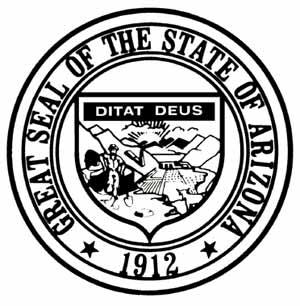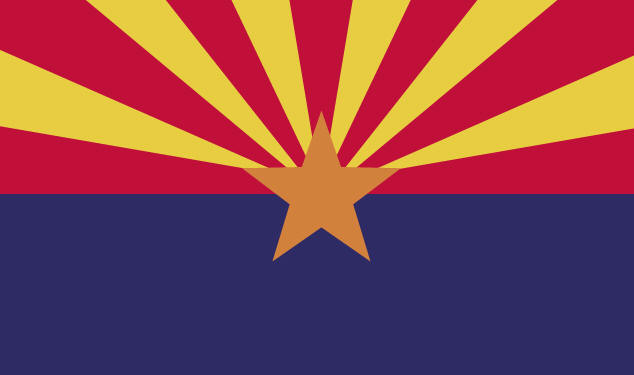DOWNTOWN PHOENIX SIGHTS
Downtown, also dubbed "Copper Square," has become an increasingly exciting
place with museums, restaurants, entertainment venues, stadiums, and shopping centers.
The Greater Phoenix Convention & Visitors Bureau (125 N. 2nd St., Suite 120,
Phoenix, AZ 85004, 602/254-6500 or 877/225-5749, 8 a.m.-5 p.m. Mon.-Fri.) provides
much helpful information at its central location.
Arizona
Center, at Third and Van Buren Sts., offers an oasis of palms, waterfalls, and pools
with a variety of restaurants and specialty shops, a 24-screen movie theater, and
some night spots. Two blocks south you'll find the oldest and the newest in
Phoenix—Heritage Square and Science Park, home of the 1895 Rosson House, Phoenix
Museum of History, and Arizona Science Center. Continue two blocks farther south
and you'll be at the huge Bank One Ballpark with its retractable roof. Turn
west two blocks and you'll reach America West Arena, another major sports center.
Other attractions in the heart of downtown include Symphony Hall, Herberger Theater,
and the Orpheum Theater—a 1929 Spanish Baroque Revival building restored to
its original elegance. Look west down Washington Street and you'll see the copper
dome of the old state capitol, where much of Arizona's past has played out.
Arizona State Capitol
With its winged figure of victory atop a shiny
copper dome, the old state capitol (1700 W. Washington St., 602/926-3620,
https://azlibrary.gov/azcm, 8 a.m.-5 p.m.
Mon.-Fri., except on state holidays, free) dates from 1900, a dozen years before
statehood. The Arizona Legislature outgrew this structure in 1960 and moved into
adjacent new quarters. The old capitol then became a museum, carefully restored
to look as it did when Arizona became a state in 1912. The Senate and House chambers
and other rooms contain period furnishings, historical photos, and tales of frontier
days. A lifelike statue of former governor George W.P. Hunt sits behind his desk
in the old governor's office. Permanent and changing exhibits occupy four levels;
at the top one you can look through the dome's skylight at the winged figure
of victory, which turns with the wind. On the lowest floor, a memorial room of the
battleship USS Arizona displays the ship's silver service, photos of
the crews, a scale model of the ship, a piece of the superstructure, and other memorabilia
of the ship sunk at Pearl Harbor in 1941. A gift shop, also on the lowest floor,
sells Arizona books and souvenirs.
You can also join free
guided tours at 10 a.m. and 2 p.m.; groups of 12 or more must schedule tours in
advance. To dig deeper into the state's past, drop into the research library,
Room 300, where you'll see the 1930s' murals Pageant of Arizona Progress
by Jay Datus. You can view many historic photos from the archives on the capitol's
website, www.azlibrary.gov/, or you can
see what the legislature is up to at www.azleg.gov/.
Free parking is available in front of the capitol at Wesley Bolin Memorial Plaza;
turn in from Adams Street. The Plaza features many commemorative monuments and an
anchor and signal mast from the USS Arizona.
|
THE STATE SEAL

The seal portrays Arizona at statehood in 1912. It contains the Latin
motto Ditat Deus, "God Enriches." On the left, a quartz
mill and a miner with pick and shovel symbolize the state's mining industry.
Fields of cotton and citrus grow in fields on the right, irrigated by the
reservoir and mountain watershed beyond. Cattle graze in the lower right.
A rising sun represents Arizona's sunny climate.
|
THE STATE FLAG

The central star has a copper color, identifying Arizona as the United
State's greatest copper producer. The red and yellow rays form a sunset,
as this is a western state, and have the colors of the Spanish flags brought
to this land by Coronado in 1540; their number 13 commemorates the original
American colonies. The solid-blue field of the lower half of the flag further
links the state with the union.
|
Wells Fargo History Museum
An 1868 Concord coach forms the centerpiece
of this Old West collection (145 W. Adams St., between 1st and 2nd Aves., 602/378-1852,
9 a.m.-5 p.m. Mon.-Fri., free). You can experience a recreated Wells Fargo office,
admire gold nuggets from Wickenburg, see antique guns, and take in the Western art
gallery. It's in the high-rise Wells Fargo building.
Phoenix Police Museum
Exhibits at this small museum (101 S. Central
Ave. and Jefferson St., 602/534-7278, 9 a.m.-3 p.m. Mon., Wed., and Fri., except
holidays, free) present the challenges and stories of men and women who have served
over the years. You'll learn of Phoenix's first marshal, Henry Garfias,
and his difficult job of dealing with lawless elements in the 1880s. Police equipment
shows the many changes in communications and transportation over the decades. A
memorial room honors those who have lost their lives or suffered injuries while
answering the call of duty.
Arizona Latino Arts & Cultural Center
Vibrant art of Latin America
focuses on Chicano and Mexican culture in the galleries (147 E. Adams St., 602/254-9817,
www.alacaz.org, 11 a.m.-6 p.m. Tues.-Sat.).
Each exhibit changes several times a year. A gift shop offers colorful art and crafts,
including prints, posters, cards, jewelry, books, and videos.
Arizona Center
Shade trees, fountains, and waterfalls provide a pleasant
respite from busy city life at this dining, entertainment, and shopping complex
(Van Buren St. between Third and Fifth Sts.,
www.arizonacenter.com). A variety of
restaurants—many with both indoor and outdoor seating—offer seafood,
Mexican, Italian, or Southwestern cuisine. An AMC 24-screen movie theater (602/956-4262)
and a few nightspots provide entertainment. Parking is available just to the north
in the same block; enter from Fillmore or Fifth Streets. Businesses will validate
your parking stub.
St. Mary's Basilica
Catholic residents built an adobe church here
in 1881 and finished the present Mission Revival-style basilica in 1914. The interior
of the basilica (E. Monroe St. between Third and Fourth Sts., 602/354-2100, 10 a.m.-2
p.m. Mon.-Fri. and during liturgies, free) contains beautiful art and symbolism
in a peaceful setting. You can purchase a An Historical Guide to the Sacred Art
of St. Mary's Basilica next door at the church office, on the corner of
Third and Monroe Streets.
Heritage and Science Park
Museums and historic buildings in this park
downtown at Fifth and Monroe Streets reflect Phoenix's past, present, and future.
You can step inside most of the historic houses and visit two large museums nearby—Phoenix
Museum of History and the Arizona Science Center. Two garages offer parking—on
the northwest corner of the park (enter from Fifth or Monroe Sts.) and south across
Washington Street (RVs and tall vehicles must park here); bring your ticket into
a museum for validation.
Heritage Square
The Victorian-style, 1895 Rosson House (602/262-5029
recording or 262-5071 office, www.rossonhousemuseum.org,
noon-3:30 p.m. Sun., 10 a.m.-3:30 p.m. Wed.-Sat., call for hours in Aug., $4 adults,
$3 seniors, $1 children 6-12) stands tall on the north side of Heritage Square.
Meticulous restoration has returned the structure—once one of Phoenix's
most elegant houses—to its original grand appearance. Guided tours tell about
its construction and former residents. Buy tickets at the Burgess Carriage House
next door.
The Burgess Carriage House has a colonial Williamsburg style
rarely seen this far west. Originally located at Second and Taylor, this was the
first of two structures moved to Heritage Square. A second carriage house (ca. 1900)
at the site is now an education center. The Lath Pavilion dates from 1980
but is typical of early Phoenix architecture.
The other buildings
on Heritage Square also represent early Phoenix. The Duplex (1923) now contains
offices; you can drop into the city office on the left for more information about
the historic buildings. The Stevens House (1901) holds the Arizona Doll and Toy
Museum (602/253-9337, noon-4 p.m. Sun., 10 a.m.-4 p.m. Tues.-Sat., closed Mon.
and Aug., $3 adults, $1 children 3-12). Beside it, the Stevens-Haustgen House
(1901) is currently closed. Next, the Bouvier-Teeter House (1899) is home
to a Japanese restaurant, Nobou (602/254-0600,
www.nobuofukuda.com, lunch and dinner Tues.-Sun.).
The 1900 Silva House, a fine example of bungalow architecture, now hosts
The Rose and Crown, which serves traditional English pub fare (602/256-0223).
Baird Machine Shop (1929) houses the popular Pizzeria Bianco (602/258-8300,
open Tues.-Sun. for dinner), which creates pizza and salads. The 1909 Thomas
House next door is home to Bar Bianco, which serves wine, beer, and appetizers.
Arizona Science Center
"Have fun with science," suggests
the Center (600 E. Washington St. in Heritage and Science Park, 602/716-2000,
www.azscience.org, 10 a.m.-5 p.m. daily except
Thanksgiving and Christmas, $12 adults, $10 children 3-17 and seniors 62+). You
can try some 300 different hands-on exhibits that make scientific exploration exciting!
Both children and adults will find the projects challenging and fun. (Mornings,
though, can be very busy with school kids.) A Play Space will entertain the age
four and under set. New and improved exhibits continually appear in such fields
as "All About You" (the workings of mind and body), "the digital
world," the mind," "Fab Lab" (exploring the nature of forces
and movement), and "The World Around You" (studying earth sciences and
aerospace). The experiments you try may be as simple as a test of perception or
as complex as working the controls of an actual helicopter. Staff present demonstrations
during the day. Radio hams at station W7ASC (www.w7asc.org)
will let you have the microphone to "work" other hams. Art exhibits and
visiting exhibitions reveal beautiful and fascinating aspects of science. A planetarium
will take you from the skies of Arizona to the mysteries of the universe. Spectacular
movies, some in 3D, play in the giant-screen IMAX Theater. The interactive fountain,
Water Works, may put on a show for you. Awesome Atom's Science Store, an intriguing
gift shop, and a small food court round out the facilities.
Chase Field Ballpark
Baseball fans will enjoy the 75-minute tour of
this amazing stadium (401 E. Jefferson St., 602/514-8400 advance purchase or 602/462-6799
information,
http://arizona.diamondbacks.mlb.com/ari/ballpark/index.jsp,
Mon.-Sat., call for times and recommended reservations, $7 adult, $5 senior 60+
and children 7-12, $3 age 4-6) that combines features of an old-fashioned ballpark
with the latest technologies. Your guide will tell of exploits by Mark McGuire and
other hitters, along with technical details such as how the retractable roof operates.
You'll see the poolside "seating" beside right field, hall of fame
exhibits, and party rooms, and you'll visit the Arizona Diamondbacks dugout.
Tours start at the ticket windows on the west side of the stadium. (Originally called
Bank One Ballpark, the stadium's name was changed to Chase Field on September
23, 2005. Bank One Corporation, which owned the naming rights to the stadium, merged
with J.P. Morgan Chase & Company in 2004.)
George Washington Carver Museum & Cultural Center
The Phoenix Union
Colored High School, built in 1926 as Arizona's first Black high school and
later named in honor of the scientist, now has exhibits (415 E. Grant St., 2 blocks
south of Chase Field, 602/254-7516,
www.carveraz.org/,
call for hours, $3 adult, $2.50 seniors 60+, $2 youth 6-12, $1 kids 3-5) that relate
the lives, challenges, and triumphs of Phoenix's African-American community.
You'll get a sense of what it was like for the Black pioneers and later generations.
Galleries tell of prominent local and national individuals, student experiences,
sports achievements, military heroes, and religious roots. Art and visiting exhibits
appear too. A library specializes in African-American subjects. The sculpture garden
contains a memorial to four girls killed in a bombing in Alabama, That Which
Might Have Been, Birmingham 1963.
On to Phoenix's Central Avenue sights

